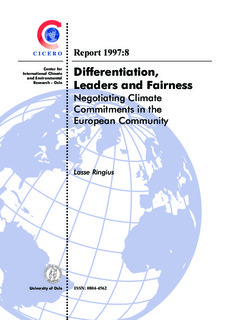| dc.contributor.author | Ringius, Lasse | nb_NO |
| dc.date.accessioned | 2014-03-17T14:30:02Z | |
| dc.date.available | 2014-03-17T14:30:02Z | |
| dc.date.issued | 1998 | nb_NO |
| dc.identifier.issn | 0804-4562 | nb_NO |
| dc.identifier.uri | http://hdl.handle.net/11250/192084 | |
| dc.description.abstract | This report shows that it is possible to negotiate and reach asymmetrical environmental agreements that take into account significant national dissimilarities. The report argues that analytical models and intuitively appealing model-based quantitative indicators of national circumstances can establish premises for negotiations leading to differentiated environmental agreements. While they cannot take the place of political negotiation, they help identify a formula that defines the problem in a resolvable fashion and prevent the bargaining space from expanding uncontrollably. Scholars arguing that symmetrical environmental measures are widely used because they simplify negotiations and prevent countries from pursuing extremist positions, and that salient focal points are significant in negotiation, overlook this argument. In pre-Kyoto European Community climate policy, which this article empirically examines, high transaction costs and EC member states’ ability to block economically hurtful agreements were not essential issues. | nb_NO |
| dc.language.iso | eng | nb_NO |
| dc.publisher | CICERO Center for International Climate and Environmental Research - Oslo | nb_NO |
| dc.relation.ispartof | CICERO Report | nb_NO |
| dc.relation.ispartofseries | CICERO Report;1997:08 | nb_NO |
| dc.title | Differentiation, leaders and fairness: Negotiating climate commitments in the European Community | nb_NO |
| dc.type | Research report | nb_NO |
| dc.source.pagenumber | | nb_NO |
